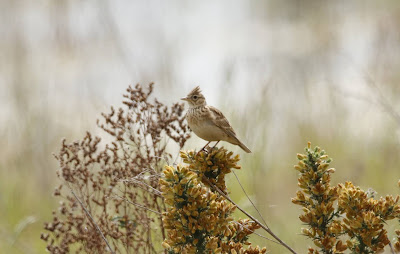For a time that can be seen as historical, not a lot has happened. The era of the coronavirus, is marked by how inactive people have been, a time which is defined by being stuck indoors. As with most activities that rely on travel, birdwatching has been badly effected. Reserves are closed, and for two months now travel has been forbidden. I'm not complaining, because there are bigger things at stake, its just that I miss going out on my little birdwatching adventures so much.
However as lockdown eases, travel is now allowed and reserves are open, although at the moment most hides and visitor centres are closed. This has a big effect for the likes of Minsmere, or Welney, reserves which provide the visitor experience, but aren't allowed to open.
A newly fledged BLUE TIT, on the river by Baylham.
I've always found photographing SKYLARKS really difficult. This is one of the few times I have ever seen one perching.
The exhausted quarry at Pipps Ford. This year the area has been able to keep a decent amount of water which has been good for birds.
On the grassland that surrounds the water, there are good numbers of SKYLARKS in what is a small area. They have stopped singing now, but are very active with flights to and from the nest to feed their chicks. They have a very distinctive way of moving their wings in flight and are quite bulky, which distinguishes them from other small birds.
The active quarry
At the moment the active quarry is a deep sided lake with a few islands. There weren't too many birds, except for a pair of TUFTED DUCK and a pair of GREAT CRESTED GREBES, which might be colonists that have failed at other sites.
What is disheartening is the low numbers of SAND MARTINS present. They nest in the shifting sandy cliff faces of the quarry every year, but there seemed to be less about at the moment, hawking low over the surrounding grassland. As they are birds of transitional habitats, their numbers do fluctuate from year to year.
One of the SWANS, with a mallard, on Pippins Lake
Pippins Lake, a larger lake bordered by tall trees, had a SWAN family with five lovely young cygnets, but not much else.
By Riverside Farm Pit there were three fledged MISTLE THRUSHES in a sheep field, and a juvenile GOLDCREST nearby, the young bird lacking the distinctive head crest of the adults.
A nice spot, just down from Pipps, is where the river passes Baylham Farm Park. Here the river splits in two, and there were masses of young birds in the surrounding mature trees. There was nothing unusual, but the sheer number of birds meant that I had some great photo opportunities, a lot of the photos on this blog were taken from this site.
The fledged BLUE TITS have yellow face and bellies, which are white on adults.
Sometimes its not about the birds you see, its just enough to see them. With lockdown still in force it has really made me appreciate my feathered friends and the countryside they live in. For several months now, I have been birdwatching my local area, no visitor centres, no hides, no other birders. These are places not manged for birds, yet the birds live here none the less, and I have greater respect for them. They have defined the lockdown period for me.
I must admit I do miss Minsmere though. I mean its the greatest reserve in the country. Maybe when things return to some form of normalcy, I will return. But at the moment I look forward to a morning's birding at Pipps Ford, a more humble destination, but one that still satisfies.
I must admit I do miss Minsmere though. I mean its the greatest reserve in the country. Maybe when things return to some form of normalcy, I will return. But at the moment I look forward to a morning's birding at Pipps Ford, a more humble destination, but one that still satisfies.








No comments:
Post a Comment